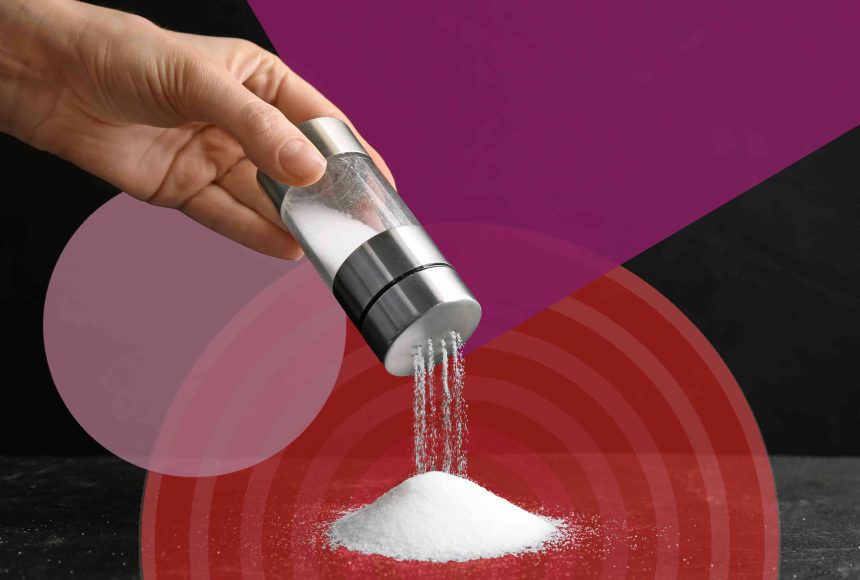Sodium is an essential micronutrient necessary for your body to run efficiently. It acts as a mineral and an electrolyte, and it’s involved in several functions. It helps move nutrients into your cells, regulates fluid balance, supports nerve and muscle function and maintains blood pressure. The problem with sodium, though, is that most of us get too much of it.
The American Heart Association recommends no more than 2,300 mg of sodium per day, but the organization says the ideal limit is even less than that, coming closer to 1,500 mg per day. But Americans are getting well beyond the recommended daily amount, averaging about 3,500 mg. Over time, this excessive amount of sodium may increase your risk of high blood pressure and, ultimately, stroke. For those who have already had a stroke and survived it, one in four will have a second stroke.
Because lowering blood pressure is a key factor in lowering stroke risk, researchers in China wanted to see if replacing salt with a salt substitute would help lower the risk of a second stroke in people who have already had a previous stroke. They published their original findings in an issue of JAMA Cardiology published today. Here’s what they found.
How Was This Study Conducted?
Researchers included people living in 600 villages in northern China who had previously experienced a stroke. This included 15,249 people with an average age of 64; just under half of them were female. Typical baseline data was collected, including medical history, blood pressure, BMI, demographics, medication use, salt-related knowledge and use of salt.
There are different types of strokes, and the group of participants included those who experienced hemorrhagic, ischemic and undetermined strokes. A hemorrhagic stroke is when a blood vessel in the brain bursts, causing bleeding in the brain. An ischemic stroke occurs when there is a blockage in a blood vessel to the brain, preventing blood and oxygen from reaching a certain region of the brain.
Participants were split into two groups. One group was the salt substitute group (intervention group) and the other was the regular salt group (control group). The control group continued to buy their salt from the store as they normally would, but the intervention group received a salt substitute that contained 75% sodium chloride and 25% potassium chloride. Standard table salt normally used for home cooking contains nearly 100% sodium chloride, usually with some kind of anti-caking agent added. Some salt substitutes you can buy at the store, including Morton’s and NoSalt, include potassium chloride.
The length of the study lasted just over 5 years. Follow-up assessments were conducted twice a year. To ensure participants were adhering to the assigned use of salt or salt substitute, researchers measured participants’ 24-hour urinary sodium and potassium excretion and blood pressure every 12 months; participants were chosen randomly so they didn’t know when or even if they’d be tested.
What Did This Study Find?
The primary factors being tested were the risk of another stroke and death rates, so researchers were tracking these statistics as well. During the 62 months of follow-up, there were a total of 2,735 recurrent strokes—691 of them fatal. Overall, throughout the study period, there were a total of 3,242 deaths, which included death from anything, not just stroke.
The intervention group using the salt substitute saw a 14% relative reduction in recurrent stroke risk overall. The association was stronger for recurring hemorrhagic strokes, with researchers calculating a 30% lower risk for this type of stroke.
The other outcomes researchers were looking at were death rates in these groups. The intervention group using the salt substitute saw an overall 12% lower risk of dying from anything during the study period—that figure is referred to as all-cause mortality. In addition, this group also had a 21% lower risk of stroke-related deaths.
Another finding of this study was a reduction in systolic blood pressure (the top number) in the salt substitution group of -2.05 mm Hg—so basically a drop of 2 “points.” While this was a modest reduction, the study authors state that previous meta-analyses indicated that even a 1-mm Hg reduction in systolic blood pressure was associated with a 5% reduction in stroke risk, as well as a reduced risk of heart disease.
How Does This Apply to Real Life?
Despite the salt substitute being made of 75% sodium, the intervention group experienced a reduction in having another stroke—and from dying from a recurrent stroke if it did happen. The study authors note that replacing table salt with a salt substitution is a simple way for people to reduce their stroke risk.
The study authors do caution, however, that these results might not apply to other parts of the world. Case in point: On average, Americans get 70% of their sodium from packaged foods, not the salt shaker. Still, swapping regular salt in your shaker with a salt substitute may still be a helpful change.
Besides a family history of stroke, age, sex and race or ethnicity, other stroke risk factors include high blood pressure, high cholesterol, heart disease, diabetes, obesity and sickle cell disease.
Your habits can also influence your risk of stroke. Habits that increase your risk include:
- Tobacco use
- Lack of physical activity
- A diet high in added sugar, saturated fat, cholesterol, trans fats and sodium
- Drinking too much alcohol—no more than one drink per day for women and no more than two drinks per day for men
- Stress
To lower your risk, change your habits. If you use tobacco, quit. If you’re not moving your body the recommended minimal amount—150 minutes a week of moderate activity or 75 minutes a week of more vigorous activity—start where you’re at and just move more often. If you’re drinking more than the maximum amount or binge drinking, cut down or stop. Stress is subjective in many ways and there are many avenues to reducing stress. But getting outside, going for a walk and practicing deep breathing is a good place to start.
Diet is also a large area to tackle but like other health habits, it’s helpful to know where you’re currently at. Keep a three- to seven-day food diary so you can see what you’re actually eating. Then choose one area and aim to add or swap. For example, if you’re not eating an average of at least five fruits and vegetables a day, start adding one serving each day, master that, then add another one and keep going. Or if you’re a daily soda drinker, start swapping one soda a day with water. Gradually progress until you’re swapping most or all of your daily sodas.
Since most of our sodium comes from packaged foods, take an inventory of what packaged foods you’re eating most often and start swapping them out with whole foods—fruits, vegetables, whole grains, unsalted nuts and seeds, legumes or lean proteins without added sodium (like what you’ll find in rotisserie chicken or marinaded meats). And cook more often at home so you have more control over how much sodium you’re eating. To add flavor without the salt, experiment with herbs and spices in your dishes. This is a fun way to change the flavor profile of a dish each time you make it.
The Bottom Line
This study suggests that by swapping your table salt with a salt substitute, you could lower your stroke risk. But it’s also important to look at the packaged foods you eat regularly, as they could be contributing to your sodium intake.
And remember, you don’t have to make any lifestyle changes alone. A registered dietitian can help you with your dietary changes. Hire a certified personal trainer or take a group class to help you get more exercise—or enlist a walking buddy. There are lots of apps that help with sleep and stress. If you need help cutting back on alcohol or tobacco use, find a group or professional in your area that specializes in quitting. And remember to show yourself some compassion. Changing habits is difficult and can take some time. Relapses are likely to happen. When they do, dust yourself off and keep going.







